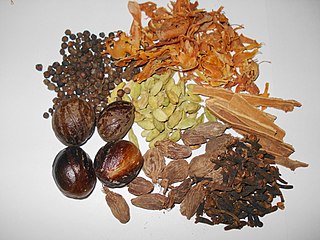
Mulled wine, also known as spiced wine, is an alcoholic drink usually made with red wine, along with various mulling spices and sometimes raisins, served hot or warm. It is a traditional drink during winter, especially around Christmas. It is usually served at Christmas markets in Europe, primarily in Germany, Austria, Switzerland, Nordics and eastern France. There are non-alcoholic versions of it. Vodka-spiked mulled wine can be found in Polish Christmas markets, where mulled wine is commonly used as a mixer.

Compote or compôte is a dessert originating from medieval Europe, made of whole or pieces of fruit in sugar syrup. Whole fruits are cooked in water with sugar and spices. The syrup may be seasoned with vanilla, lemon or orange peel, cinnamon sticks or powder, cloves, other spices, ground almonds, grated coconut, candied fruit or raisins. The compote is served either warm or cold.

The Forme of Cury is an extensive 14th-century collection of medieval English recipes. Although the original manuscript is lost, the text appears in nine manuscripts, the most famous in the form of a scroll with a headnote citing it as the work of "the chief Master Cooks of King Richard II". The name The Forme of Cury is generally used for the family of recipes rather than any single manuscript text. It is among the oldest extant English cookery books, and the earliest known to mention olive oil, gourds, and spices such as mace and cloves.

Sangria is an alcoholic beverage originating in Spain and Portugal. A punch, sangria traditionally consists of red wine and chopped fruit, often with other ingredients or spirits.

Gingerbread refers to a broad category of baked goods, typically flavored with ginger, cloves, nutmeg, and cinnamon and sweetened with honey, sugar, or molasses. Gingerbread foods vary, ranging from a moist loaf cake to forms nearly as crisp as a ginger snap.

Spice mixes are blended spices or herbs. When a certain combination of herbs or spices is called for in a recipe, it is convenient to blend these ingredients beforehand. Blends such as chili powder, curry powder, herbes de Provence, garlic salt, and other seasoned salts are traditionally sold pre-made by grocers, and sometimes baking blends such as pumpkin pie spice are also available. These spice mixes are also easily made by the home cook for later use.

A hot toddy, also known as hot whiskey in Ireland, is typically a mixed drink made of liquor and water with honey, lemon, herbs and spices, and served hot. Recipes vary, and hot toddy is traditionally drunk before retiring for the night, in wet or cold weather or to relieve the symptoms of the cold and flu. In How to Drink, Victoria Moore describes the drink as "the vitamin C for health, the honey to soothe, the alcohol to numb."

Mincemeat is a mixture of chopped dried fruit, distilled spirits and spices, and often beef suet, usually used as a pie or pastry filling. Mincemeat formerly contained meat, notably beef or venison. Many modern recipes replace the suet with vegetable shortening. Mincemeat is found in the Anglosphere.

Carrot cake is cake that contains carrots mixed into the batter.

Christmas cookies or Christmas biscuits are traditionally sugar cookies or biscuits cut into various shapes related to Christmas.

There are many cocktails made with cachaça, the national spirit of Brazil. The caipirinha is by far the most popular and internationally well-known, but bartenders have developed other mixed drinks using the spirit.

Pumpkin pie spice, also known as pumpkin spice, is an American spice mix commonly used as a flavoring for pumpkin pie, but does not include pumpkin as an ingredient.
Powder-douce is a spice mix used in Medieval and Renaissance cookery. Like modern spice mixes such as "Italian seasoning," "garam masala," "taco seasoning," etc., there was not a set ingredient list, it varied from cook to cook. The author of the 14th-century manuscript Le Ménagier de Paris suggested a mix of grains of paradise, ginger, cinnamon, nutmeg, sugar, and galangal.

Smoking Bishop is a type of mulled wine, punch, or wassail, especially popular in Victorian England at Christmas time, and it is mentioned in Dickens' 1843 story A Christmas Carol.

Masala chai is a popular beverage throughout South Asia, originating in early modern Indian subcontinent. Chai is made by brewing black tea in milk and water and then sweetening with sugar. Adding aromatic herbs and spices creates masala chai, although chai is often prepared unspiced.

Qatari cuisine is made up of traditional Arab cuisine. Machbūs, a meal consisting of rice, meat, and vegetables, is the national dish in Qatar, typically made with either lamb or chicken and slow-cooked to give it a depth of flavour. Seafood and dates are staple food items in the country. Many of these dishes are also used in other countries in the region, because they share many commonalities. In other parts of the region some of the dishes have different names or use slightly different ingredients. One proponent of the importance of Qatar's culinary heritage is chef Noor Al Mazroei, who adapts traditional recipes to include vegan and gluten-free alternatives.
An aromatised wine is a fortified wine or mistelle that has been flavoured with herbs, spices, fruit or other natural flavourings.

The Good Huswifes Jewell is an English cookery book by the cookery and housekeeping writer Thomas Dawson, first published in 1585. It includes recipes for medicines as well as food. To the spices found in Medieval English cooking, the book adds herbs, especially parsley and thyme. Sugar is used in many of the dishes, along with ingredients that are uncommon in modern cooking like violets and rosewater.
















